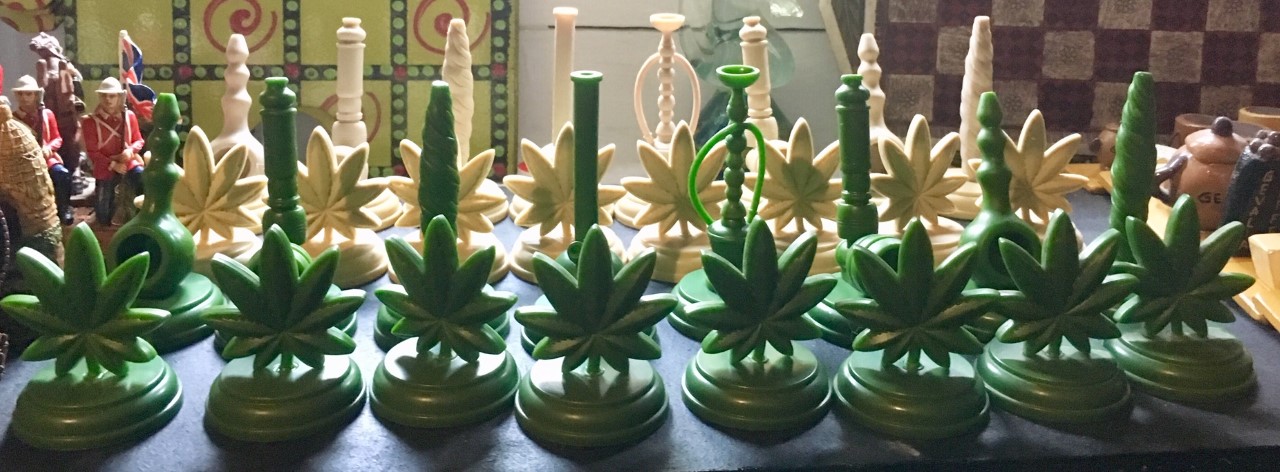Fifty years ago, the legendary Woodstock Festival took place in the United States. A year later its Dutch equal was celebrated in Rotterdam.
Chess is a serious activity, isn’t it? The weed-themed chess pieces, outfitted in the colours of the city of Rotterdam, certainly add a relaxed note to the game. The reason we are putting the spotlight on this set is the Holland Pop Festival. This music festival started on 26 June 1970, on the banks of the Kralingse Plas Lake, where the joints and bongs were plentiful. This ´peaceful festival of happy folks´ (as reported by Dutch daily AD on 29 June 1970) was to last three days, which made it the first multi-day, open-air festival on the European continent.
At that time, the United States were the leading example when it came to multi-day festivals that were full of alternative music, drugs and love & peace ideals. The US were not only the birthplace of the hippie movement but also that of pop culture. In the fifties, folk festivals were organised in the open air and at these events you could also listen to pop and rock music. In the following decade, pop bands started playing in open stadiums, like the Beatles during their America tour in 1966. The outdoor music festivals coincided with the rise of the hippie movement in San Francisco which consisted of youngsters who opposed civil society and who were clearly recognisable by their clothing, hair style, but also their alternative taste in music.
Foreign bands
Large, multi-day meetings organised for and by this group that lived out their own peaceful lifestyle became the fashion. Being together, listening to music, but also taking drugs were all important activities at this kind of events. Tens of thousands of hippies flocked to these music festivals, with Woodstock as the legendary highlight. Many important artists of that time performed during this festival, which attracted more than 400,000 visitors. No more than 200,000 people were expected…
The following year, on 27 and 28 June 1970, a multi-day festival featuring some big names took place in Bath, England. This made it possible for the organizers of the Holland Pop Festival to book many foreign bands: they only had to cross the North Sea. The line-up in Kralingen was heaven for music lovers, with famous names such as Pink Floyd, Jefferson Airplane, Santana, and even The Byrds. Never before had so many famous foreign bands performed in the Netherlands at the same time, and for three consecutive days! On the stages of the still existing Pink Pop festival, for example, of which the first edition had taken place in that same year, the main acts were mostly Dutch bands.
From far and wide

Rob Mieremet (ANEFO) – GaHetNa (Nationaal Archief NL) 923-6254
Holland Popfestival 1970, Kralingen, Rotterdam
The music turned out not to be the only attraction, or even the main one. Far from it… During the festival, the government put to work several sociologists who conducted surveys among 1,100 visitors. The atmosphere, personal freedom and being together with a large group of like-minded people had been important reasons for the visitors to travel to Kralingen. And they came from far and wide: 21% of the visitors were foreigners, a big part of them Americans. The Dutch also came to Rotterdam from all over the country.
In total, the Holland Pop Festival attracted between 60,000 and 100,000 visitors, three-quarters of whom were under the age of 22. The real number of visitors is uncertain though because the majority of the people entered the site without paying. Only 30,000 people had bought a ticket, the rest of the visitors managed to enter the terrain avoiding the official entrance. The stewards were too busy listening to the music instead of guarding the site. Among the hundreds of volunteer stewards were many music lovers who could attend the festival for free because of their job.
Drug Team
And then there were the drugs. According to the survey, half of the visitors used drugs, many of them for the first time. The atmosphere was very relaxed, the visitors sat or lay comfortably in the grass and the drugs were passed around freely. The festival terrain was a kind of free state for three days, the police being officially absent. There was a police station outside the gate, but they did not take any action against the drug use inside. There were undercover agents in raincoats who did not go unnoticed. They were quite out of tune with the rest of the festival goers in their hippie outfits.
The organizers themselves were well prepared for any unpleasant consequences of the drug use. They had appointed a drug team of 70 doctors, counsellors and other assistants. This team kept a close eye on the festival goers and assisted them mainly with vitamin C tablets and good advice. The team noticed that most of the festival goers knew little to nothing about the drugs they had taken. There were not a lot of casualties though: the team helped 500 people who had become unwell but only 10 of them ended up in hospital.
Nowadays the use of weed is regulated and therefore a lot less exotic than it was for the young people who were at the Kralingse Plas Lake in 1970. The weed leaf as a symbol is no longer only associated with hippies. So we are not really surprised to find a chess game with weed and bong pieces in the Chessmen Museum.




You must be logged in to post a comment.